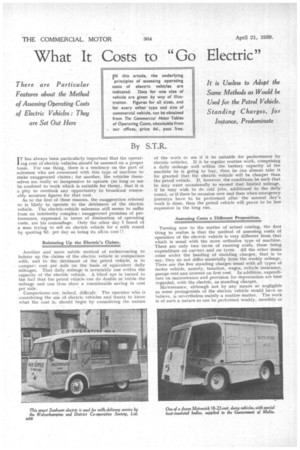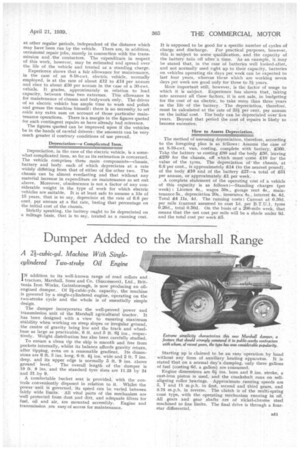What It Costs to "G Electric"
Page 86

Page 87

If you've noticed an error in this article please click here to report it so we can fix it.
IT has always been particularly important that the operating cost of electric vehicles should be assessed on a proper
• basis, For one thing, there is a tendency on the part of salesmen who are concerned with this type of machine to Make exaggerated claims ; for another, the vehicles themselves are really so inexpensive to operate (so long as use be confined to work which is suitable for them), that it is a pity to overlook any opportunity to broadcast reasonably accurate figures for that cost.
As to the first of these reasons, the exaggeration referred to is likely to operate to the detriment of the electric vehicle. The electric-vehicle salesman still seems to suffer from an inferiority complex: exaggerated promises of performance, expressed in terms of diminution of operating costs, are his camouflage. Only the other day I heard of a man trying to sell an electric vehicle for a milk round by quoting Ed. per day as being its all-in cost!!
Bolstering Up the Electric's Claims.
Another and more subtle method of endeavouring to bolster up the claims of the electric vehicle in comparison with, and to the detriment of the petrol vehicle, is to compar-i cost per mile on the basis of equivalent daily mileages. That daily mileage is invariably one within the capacity of the electric vehicle. A blind eye is turned to the fact that the petrol vehicle can do double or treble the mileage and can thus show a considerable saving in cost per mile, Comparisons are, indeed, difficult. The operator who is considering the use of electric v eh cle s and Wants to know what the cost is, should begin by considering the nature of the work te see if it be suitable for performance by electric vehicles. If it be regular routine work, comprising a daily mileage well within the battery capacity of the machine he is going to buy, then be can almost take it for granted that the electric vehicle will be cheaper than the petrol vehicle. If, however, the conditions be such that he may want occasionally to exceed that limited mileage, if he may wish to do odd jobs, additional to the daily round, orsif there be occasion now and then when emergency journeys have to be performed after the normal day's work is done, then the petrol vehicle will prove to be less expensive in the long run.
Assessing Costs a Different Proposition.
Turning now to the matter of actual costing, the first thing to realize is that the method of assessing costs of operation of the electric vehicle is very different from that which is usual with the more orthodox type of machine. There are only two items of running costs, these being expenditure on current and on tyres. All the other items come under the heading of standing charges, that is to say, they do not differ materially from the weekly mileage. There are the five standing charges usual with all types of motor vehicle, namely, taxation, wages, vehicle insurance, garage rent and interest on first cost. In addition, expenditure on maintenance and provision for depreciation are best regarded, with the electric, as standing charges.,
Maintenance, although not by any means so negligible as some protagonists of the electric vehicle would have us believe, is nevertheless mainly a routine matter. The work is of such a nature as can be performed weekly, monthly or at other regular periods, independent of the distance which may have been run by the vehicle. There are, in addition, occasional repair jobs, mainly in connection with the transmission and the contactors. The expenditure in respect of this work, however, may be estimated and spread over the life of the vehicle and treated as a standing charge.
Experience shows that a fair allowance for maintenance, in the case of an 8-10-cwt. electric vehicle, normally employed, is at the rate of about £12 to £14 per annum and rises to about £80 per annum in the case of a 30-cwt. vehicle. It grades, approximately in relation to load capacity, between these two extremes. This allowance is for maintenance of chassis and bodywork only. The driver of an electric vehicle has ample time to wash and polish and grease the machine• himself : there is no necessity, to set aside any extra sum on account of those particular maintenance operations. There is a margin in the figures quoted for such contingent repairs as have already had reference. The figures quoted can be improved upon if the vehicles be in the hands of careful drivers: the amounts can be very much greater if contrary conditions of use prevail.
Depredation—a Complicated Item.
Depreciation, in the case of the electric vehicle, is a somewhat complicated item, so far as its estimation is concerned. The vehicle comprises three main components—chassis, battery and body each of which depreciates at a rate widely differing from that of either of the other two. The chassis can be almost everlasting and that without any material increase in expenditure on maintenance as set out above. Moreover, obsolescence is not a factor of any considerable weight in the type of work for which electric vehicles are suitable. It is at least safe to assume a life of 15 years, that is to say, depreciate at the rate of 6.6 per cent. per annum at a fiat rate, basing that percentage on the initial cost of the chassis.
Strictly speaking, the battery ought to be depreciated on a mileage basis, that is to say, treated as a running cost.
It is supposed to be good for a specific number of cycles of
charge and discharge. For practical purposes, however, this is subject to some qualification, and the capacity of the battery taiis off after a time. As an example, it may be stated that, in the case of batteries well looked-after, and not normally used right up to their capacity, batteries , on vehicles operating six days per week can be expected to last four years, whereas these which are working seven days per week are good only for three to 3+ years. More important still, however, is the factor of usage to which it is subject. Experience has shown that, taking into account all these factors, it is not safe, in budgeting
• for the cost of an electric, to take more than three years as the life of the battery. The depreciation, therefore, must be calculated at the rate of 33+ per cent, per annum on the initial cost. The body can be depreciated over five years. Beyond that period the cost of repairs is likely to become excessive.
How to Assess Depreciation.
The method of assessing depreciation, therefore, according to the foregoing plan is as fellows: Assume the case of an 8-10-cwt. van, costing, complete with battery, £360. Take the battery as costing £80 and the body £50, leaving £230 for the chassis, off which must 'come £10 for the value of the tyres. The depreciation of' the chassis, at 6.6 per cent., is approximately £14 (to the nearest pound), of the body £10 and of the battery £27—a total of £51 per annum, or approximately £1 per week. A complete statement of the operating cost of a vehicle of this capacity is as follows :—Standing charges (per week) : Licence 4s„ wages 50s., garage rent 4s., maintenance 5s., depreciation 20s., insurance 4s., interest 4s. 4d. Total £4 us. 4d. The running costs: Current at 0.30d. per mile (current assumed 'to cbst 1d. per B.T.U.), tyres 0.20d., total 0.50d. On the basis of a 200-mile week, that means that the net cost per mile will be a shade under Od. and the total cost per week £5.






































































































































